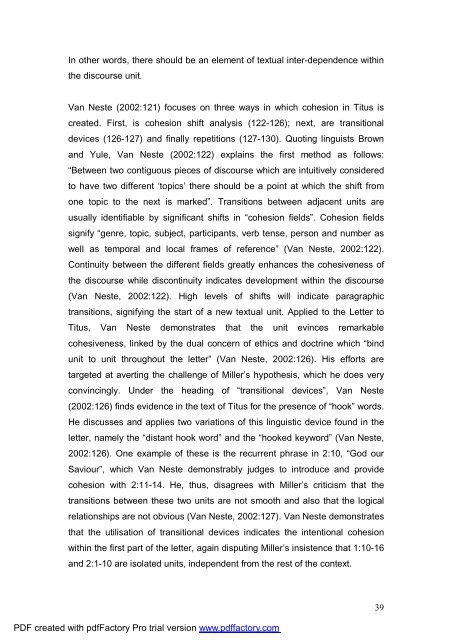A Text centred rhetorical analysis of Paul's Letter to Titus
A Text centred rhetorical analysis of Paul's Letter to Titus
A Text centred rhetorical analysis of Paul's Letter to Titus
You also want an ePaper? Increase the reach of your titles
YUMPU automatically turns print PDFs into web optimized ePapers that Google loves.
In other words, there should be an element <strong>of</strong> textual inter-dependence within<br />
the discourse unit.<br />
Van Neste (2002:121) focuses on three ways in which cohesion in <strong>Titus</strong> is<br />
created. First, is cohesion shift <strong>analysis</strong> (122-126); next, are transitional<br />
devices (126-127) and finally repetitions (127-130). Quoting linguists Brown<br />
and Yule, Van Neste (2002:122) explains the first method as follows:<br />
“Between two contiguous pieces <strong>of</strong> discourse which are intuitively considered<br />
<strong>to</strong> have two different ‘<strong>to</strong>pics’ there should be a point at which the shift from<br />
one <strong>to</strong>pic <strong>to</strong> the next is marked”. Transitions between adjacent units are<br />
usually identifiable by significant shifts in “cohesion fields”. Cohesion fields<br />
signify “genre, <strong>to</strong>pic, subject, participants, verb tense, person and number as<br />
well as temporal and local frames <strong>of</strong> reference” (Van Neste, 2002:122).<br />
Continuity between the different fields greatly enhances the cohesiveness <strong>of</strong><br />
the discourse while discontinuity indicates development within the discourse<br />
(Van Neste, 2002:122). High levels <strong>of</strong> shifts will indicate paragraphic<br />
transitions, signifying the start <strong>of</strong> a new textual unit. Applied <strong>to</strong> the <strong>Letter</strong> <strong>to</strong><br />
<strong>Titus</strong>, Van Neste demonstrates that the unit evinces remarkable<br />
cohesiveness, linked by the dual concern <strong>of</strong> ethics and doctrine which “bind<br />
unit <strong>to</strong> unit throughout the letter” (Van Neste, 2002:126). His efforts are<br />
targeted at averting the challenge <strong>of</strong> Miller’s hypothesis, which he does very<br />
convincingly. Under the heading <strong>of</strong> “transitional devices”, Van Neste<br />
(2002:126) finds evidence in the text <strong>of</strong> <strong>Titus</strong> for the presence <strong>of</strong> “hook” words.<br />
He discusses and applies two variations <strong>of</strong> this linguistic device found in the<br />
letter, namely the “distant hook word” and the “hooked keyword” (Van Neste,<br />
2002:126). One example <strong>of</strong> these is the recurrent phrase in 2:10, “God our<br />
Saviour”, which Van Neste demonstrably judges <strong>to</strong> introduce and provide<br />
cohesion with 2:11-14. He, thus, disagrees with Miller’s criticism that the<br />
transitions between these two units are not smooth and also that the logical<br />
relationships are not obvious (Van Neste, 2002:127). Van Neste demonstrates<br />
that the utilisation <strong>of</strong> transitional devices indicates the intentional cohesion<br />
within the first part <strong>of</strong> the letter, again disputing Miller’s insistence that 1:10-16<br />
and 2:1-10 are isolated units, independent from the rest <strong>of</strong> the context.<br />
PDF created with pdfFac<strong>to</strong>ry Pro trial version www.pdffac<strong>to</strong>ry.com<br />
39

















